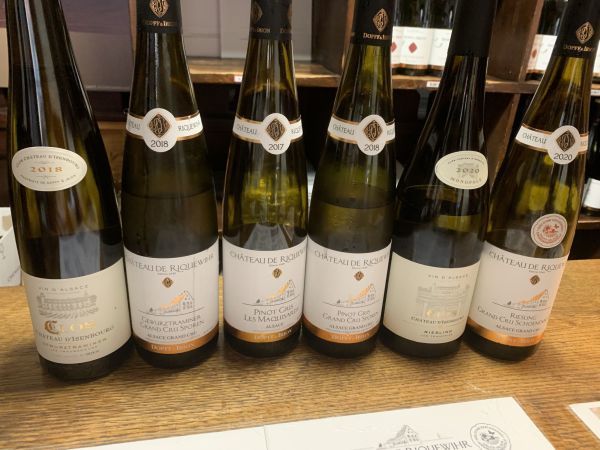.jpg)
It’s that time of year, with cold and dark nights, where Port really comes into its own. There is something just so right about enjoying a glass of Port at the end of your meal (or for that matter when your fancy takes you).
The history of Port emphasises that necessity is the mother of invention, with the additional alcohol added to “fortify” the wine, originally as a method of preserving the wine in good condition. This was especially required when the wine was supplied to the Royal Navy by England’s oldest ally (Portugal) from the seventeenth century onwards. This historical connection between Port and England is reflected in the many English names associated to this day with the Port trade, such as Taylor’s, Graham’s, Dow’s and Croft.
The grapes to make Port are grown in the baking heat of the Douro Valley, some distance inland from Oporto where the River Douro enters the Atlantic. In these hot, dry conditions, on steep-sided hills overlooking the river, the grapes are fully ripened with intense flavours and high levels of sugar.
Port is always a blend of grape varieties, with the most important being Portugal’s own Touriga Nacional and Touriga Franca with Tinta Roriz (Spain’s Tempranillo under its local Portuguese name).
All red Port production starts out as conventional red winemaking, but the fermentation process, converting the sugar in the grapes to alcohol is interrupted and terminated abruptly half way through the process on by the addition of 77% abv brandy, which raises the overall abv of the wine to 20%. As this is way beyond the level that yeast can tolerate, fermentation stops, leaving the wine as medium sweet due to the sugar that has not been converted to alcohol.
So far, all red Port follows the same process, but now the various styles of Port start to come into play. At the most generic, there are two types of Port - Ruby and Tawny. Ruby Port has had limited ageing in oak and retains its deep ruby colour. Tawny Port has had extended ageing in oak and as a result has lost much of its colour and turned Tawny.
Within the Ruby category there is generic Ruby, a fiery, fruity wine with rather more power than style. Next up in terms of quality there is Reserve Port, which is a notably more elegant wine with concentrated black fruits and rather better integration of alcohol. Perhaps the “sweet spot” for Ruby Port in terms of value for money is “Late Bottled Vintage”. LBV Port was invented by Taylor’s as a way of giving customers something approaching a true vintage Port but at a fraction of the price and without the need to wait for many years and decant. LBV Port has style, elegance and power in a great balance. Finally, Vintage Port, produced only in exceptional years, is bottled unfiltered and is designed to age for many years. In their youth the tannins are fierce but as they soften with age the wine becomes incredibly complex. Patience is eventually rewarded, but remember to decant as they throw a notable sediment.
Generic Tawny Port is aged for only a short period in wood and whilst it may develop some dried fruit and nutty characteristics its main purpose is to signpost the way to much more interesting Tawny Ports. Tawny Ports with a specified age “10 Years, 20 Years etc” are much more interesting. As they get older, they lose more of their original ruby colour and become tawny and eventually brown. Their tannins soften beautifully and the wines develop intense notes of dried fruit, nuts and marzipan.
Ruby style ports (especially LBV and Vintage) are of course known as great accompaniments to mature and blue cheese such as Stilton and Cheddar. They also work sublimely well with dark chocolate, Christmas cake and raspberries.
Tawny style ports by comparison are great matched alongside milk chocolate, nuts, soft cheese such as Camembert (a very popular combination in France) or caramel.
Four To Try
Dow's Trademark Finest Reserve Port 75cl (Sainsbury’s £10.00)
Rich ruby colour. On the nose packed with rich and concentrated strawberry fruit, and hints of spices. On the palate, full fruit flavours, well balanced, and with a long slightly dry finish that is the hallmark of all Dow's Ports.
Taylor’s Late Bottled Vintage Port (Morrison’s £10.00 (limited special offer, usually £15.00)
Rich, velvety, cherry and plum-laced Late Bottled Vintage full of character. A perfect port from a massive name in the business. Red-fruit-packed, gorgeously coloured and deliciously smooth, this is a sure-fire post-dinner smash at any table.
Graham’s 10-Year-Old Tawny Port (Tesco £20.00)
A decade of careful slow oak maturation has resulted in a wine with complex nutty aromas, combined with hints of honey and figs. On the palate, rich mature fruit flavours, beautifully mellowed with a luscious long finish.
Tanners Vintage Port 2017 (Tanners Wine Merchants £39.50)
A deep rich wine full of blackcurrant fruit with lovely concentration, fruity and elegant allowing it to be drunk young for its vibrant fruit or kept for 15 years+ to add complexity.

.jpg)
.jpg)

